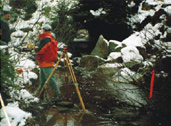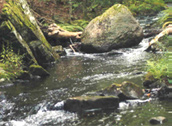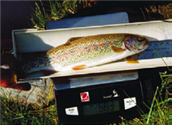 Ecological Inventories
Ecological Inventories
Creating an inventory of species, and identifying the ecotypes of a property, are key components to informed land use management. Whether for an ecological risk assessment, land development, environmental assessment, or other purpose, determining what species are present, and what ecological interactions are occurring both on a property and with adjacent areas, is necessary. East Coast Aquatics provides ecotyping and inventories of fish, butterflies, aquatic invertebrates, small mammals, reptiles, and amphibians. Species and their requirements are then compared to various species at risk lists and the ecotypes found on a property to help develop a complete ecological inventory.
 Environmental Effects Monitoring
Environmental Effects Monitoring
Environmental Effects Monitoring (EEM) programs help determine the impact or changes that occur to the environmental quality and species composition of an eco-system. Such programs are often a requirement of Regulatory Agencies. Collection of data at appropriate and key times of the year over a number of years are used to help quantify changes that may be occurring. Use of control sites in these programs allows differentiation between natural fluctuation and changes due to other factors. Water quality sampling and evaluation for chemical and metal parameters are typical components of such EEM programs. Fish toxicity testing, macroinvertebrate sampling and identification, stream morphology monitoring, stream discharge, and fish surveys are other potential monitoring components for which East Coast Aquatics can provide assistance.
 Stream Surveys
Stream Surveys
Longitudinal and cross sectional elevation surveys are critical to proper design and placement of structures in and about a stream. Such knowledge helps to ensure that particular flood return events will be considered in design of any project that encroaches the stream channel. Quantifying the meander length, radius of curvature, or width to depth ratio helps provide for sound decision making on project siting, design, and potential channel responses. Bankfull elevation and stream gradient are key components in identifying how in stream modifications may affect channel capacity.
 Stream Habitat Assessment
Stream Habitat Assessment
Habitat assessments provide insight into the value of a stream reach to a specific target species. Conducting a habitat assessment for a target fish species identifies potential limiting habitats in production; quantifies the value of a stream reach for fish productivity; and helps determine impacts to the aquatic ecosystem. This information is used for informed management decision making; and for rehabilitation projects that enhance spawning, rearing, holding, or overwintering quality and capacity. East Coast Aquatics has developed a formal stream survey methodology that is both quantitative and replicable. A stream profile, residual pool depths, large woody debris tally, bank full measures, and stream gradient are part of the measures that are collected. Methodologies follow proven techniques and results are analysed and compared to biostandard diagnostic tables and control sites. Mapping and reporting provide a comprehensive documentation of current habitat quality, impacts, and recommendations for management.
 Stream Inventories / Fish Identification
Stream Inventories / Fish Identification
Identification of fish species, population size,and age composition is carried out by various means. Electrofishing, gee traps, angling, beach seines, and snorkel counts are proven identification techniques used to conduct fish surveys. The completion of data cards documents the physical measurements of a fish, catch effort, and catch method. A site card documents the site and water quality parameters, thereby helping to provide valuation of stream system characteristics to a target species. Samples and scales can be examined to provide further assessment of population characteristics. Mapping products can graphically present fish bearing streams, known barriers to migration, upper bound of confirmed presence, and species composition.

